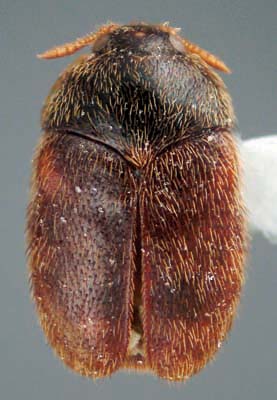
Adult khapra beetle, Trogoderma
granarium.
(Photographer: S. Weingarten, University
of Florida)
The khapra beetle is one of the most important pests of stored grain in the world, except for the U.S. Infestations discovered in the U.S. have been eradicated. Any possible adults or larvae of this species discovered in the U.S. should be immediately reported to your state regulatory service. This species prefers dried vegetable matter to preserved animal matter but will attack almost anything of organic origin. The larvae feed on oilseeds, cereals, cocoa, wheat, barley, rice, dried blood, dried milk, and fish meal. They will also eat pollen and dead insects. The young larvae feed on damaged kernels while the older larvae feed on whole kernels and seeds. Adults rarely feed.
Adult beetles are 2 to 3 mm long, with the females larger than the males. They are oblong in shape and a uniformly dark brown to black, or a mottled dark brown with black mixed in. The adults are covered with hairs. They have short antennae, with a club of three to five segments, which fit into a groove in the side of the pronotum. Adults have wings but are not known to fly. Adult females lay an average of 35 eggs over a period of three to 12 days. Larvae grow to about 5 to 6 mm in length and are yellowish brown. They are covered with long, yellowish brown hairs with tufts of hairs growing from the hardened plates. The larvae can diapause under adverse conditions. Under favorable conditions the life cycle can be completed in 30 days. Adults usually live less than two weeks, but may live considerably longer.
Images
To save the Web-optimized images shown below to your hard drive:
|
Click to access Display and Print quality images. |